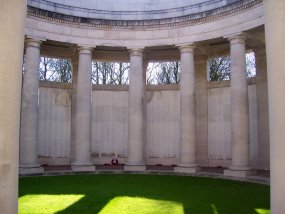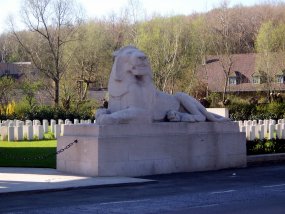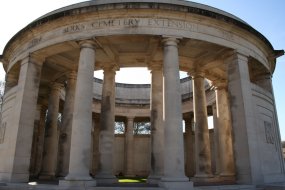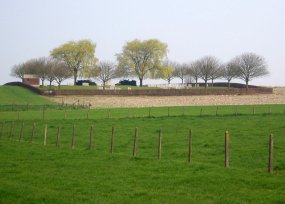
WWII: Maginot Line | Normandy | V-Weapon Sites | Arnhem
Further afield: Crete
| Home Tracing Military Ancestors Travel Advice CWGC Cemeteries Iron Harvest News Book Reviews Glossary Links Contact Me Ypres:
 
|
Core Location 13 – Ploegsteert Memorial, Hyde Park Corner
Directions – Rejoin the main road (N365) exiting Mesen to the south and within 3½ km you’ll reach the Ploegsteert Memorial on the right, flanked by two stone lions. Park next to the memorial. Practical Information – Be very careful when crossing the road between the memorial and the cemetery opposite – cars can reach quite a speed on this stretch. There are also a number of cemeteries and blockhouses to see in Ploegsteert Wood itself if you have time. For this, drive back towards Ieper on the main road and take the next right to the edge of the wood. The British, understandably, knew the area as “Plugstreet”. Historical Notes – The village of Ploegsteert and its wood, which stretches to the east of the memorial, lie at the very southern extremity of the Ypres Salient. The frontline, for most of the war, ran down the eastern edge of the wood across ground that was so waterlogged that in places the two sides had to build breastworks (fortifications above ground level) rather than trenches. The Germans heavily attacked the area during First Ypres but the line was held and remained fairly static until the Australians pushed the line further to the east during the Battle of Messines in June 1917. The entire sector including the wood was taken during the German Lys offensive in 1918 and then finally recaptured by the British 31st Division in September 1918. A number of famous writers fought at Ploegsteert including Bruce Bairnsfarther, the renowned creator of the “Old Bill” cartoons, and A.A. Milne - known to children around the world as the creator of Winnie the Pooh. The Ploegsteert Memorial was designed by Sir Gilbert Ledward and unveiled in 1931. It records the names of 11,447 British soldiers who fell in the southern sector of the Salient and in northern France – many here fell during the Fourth Battle of Ypres in 1918.
Personal Connection – My own great-great uncle fought here during First Ypres. He was a trooper in the 3rd Hussars, 2nd Cavalry Division, which was used to reinforce the depleted southern sector at the height of the German offensive. In early December 1914, whilst in the trenches around Ploegsteert Wood, he was struck in the hand. Too far gone, it was amputated and he was discharged back to England. After the war he left his job as a postman and became a farmer, naming his farm “Warneton” after the village opposite his trench in Belgium where his terrible injury had occurred. No one in the family knew the significance of the name until I researched his service papers in the Public Records Office – an example of how deeply the war left its mark on the men of this generation. Eyewitness Account – Bruce Bairnsfather, served in the trenches to the east of Ploegsteert Wood with the 1st Royal Warwicks on Christmas Day 1914. He described what happened in “Bullets and Billets”: "...a complete Bosche figure suddenly appeared on the parapet, and looked about itself. This complaint became infectious… This was the signal for more Bosche anatomy to be disclosed... until, in less time than I takes to tell, half a dozen or so of each of the belligerents were outside their trenches and were advancing towards each other in No Man’s Land. Extract taken from Walking the Salient by Paul Reed, Leo Cooper 1999. |
||||||||




